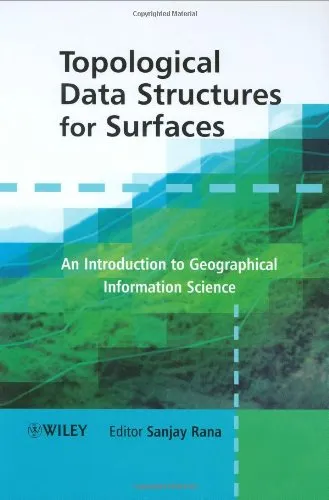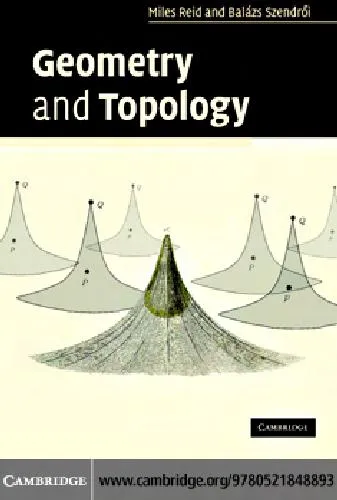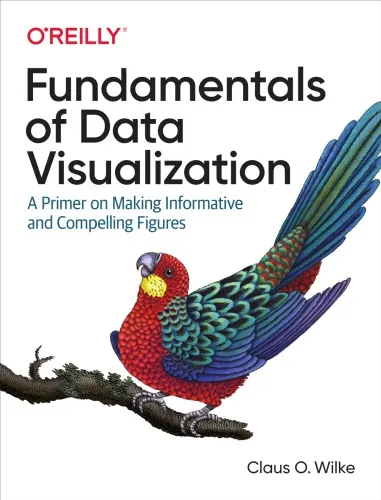Topological Data Structures for Surfaces: An Introduction to Geographical Information Science
4.0
بر اساس نظر کاربران

شما میتونید سوالاتتون در باره کتاب رو از هوش مصنوعیش بعد از ورود بپرسید
هر دانلود یا پرسش از هوش مصنوعی 2 امتیاز لازم دارد، برای بدست آوردن امتیاز رایگان، به صفحه ی راهنمای امتیازات سر بزنید و یک سری کار ارزشمند انجام بدینکتاب های مرتبط:
معرفی کتاب
کتاب Topological Data Structures for Surfaces: An Introduction to Geographical Information Science نوشته سانجای رانا، یکی از منابع ارزشمند در حوزه Geographical Information Science است. این کتاب به شکلی دقیق و عمقی به بررسی Topological Data Structures و نحوه استفاده از آنها برای تحلیل سطوح و دادههای مکانی میپردازد. با استفاده از سبک نوشتاری ساده و در عین حال تخصصی، این اثر دانشجویان و متخصصین علاقهمند به GIS را درک بهتری از ساختارهای توپولوژیک و کاربردهای آنها در عرصههای مختلف یاری میرساند.
خلاصه جامع کتاب
هدف اصلی این کتاب توضیح اهمیت ساختارهای توپولوژیک برای مدلسازی و مدیریت دادههای مکانی بهویژه برای تحلیل سطوح است. کتاب با مقدمهای بر اصول اولیه GIS و توپولوژی آغاز میشود و سپس به مفاهیم پیشرفتهتر، از جمله روشهای بازنمایی داده برای مدل کردن surfaces و تحلیل روابط توپولوژیک، میپردازد.
نویسنده با ارائه مثالهای کاربردی و استفاده از موارد واقعی، ابزارهای لازم برای درک رفتار دادههای مکانی در محیطهای پیچیده را ارائه میدهد. این نمونهها، مطالعه این کتاب را برای علاقهمندان به GIS و تحلیل دادههای جغرافیایی جذابتر و عملیتر میسازد.
برخی از مباحث کلیدی که در این کتاب مورد بررسی قرار گرفتهاند عبارتند از: نحوه کار با Triangulated Irregular Networks (TINs)، استفاده از planar graphs در توپولوژی، و اصول بنیادی پیادهسازی ساختارهای توپولوژیک برای مدلسازی پیچیدهتر سطوح.
نکات کلیدی کتاب
- آشنایی با اصول اساسی توپولوژی و ارتباط آن با GIS
- توضیح ساختارهای مختلف دادهای مانند Adjacency List
- بیان روشهای مدیریت دادههای هندسی و غیرهندسی در منابع جغرافیایی
- تحلیل ساختارهای پیشرفته مانند Voronoi Diagrams و Delaunay Triangulations
جملات معروف از کتاب
"Understanding relationships within and between geographical features is pivotal to effective spatial analysis."
"Topological representations serve as the backbone of advanced GIS systems, enabling efficient and precise analyses."
چرا این کتاب مهم است؟
در دنیای امروز که رشد دادههای مکانی بیسابقه است، تحلیل مؤثر این دادهها به یک ضرورت تبدیل شده است. ساختارهای توپولوژیک به عنوان یکی از پایههای تحلیل دادههای جغرافیایی، ابزارهای قدرتمندی برای پردازش اطلاعات ارائه میدهد. این کتاب نهتنها دانش پایهای را به تصویر میکشد، بلکه با ارائه ابزارها و تکنیکهای مدرن، خواننده را برای مقابله با چالشهای واقعی آماده میسازد.
استفاده از این کتاب میتواند برای دانشجویان، پژوهشگران، و تحلیلگرانی که در زمینه GIS فعالیت میکنند، جهت تأثیرگذاری عمیقتر در پروژههای خود راهاندازی مناسبی باشد و درک بهتری از کاربردهای ساختارهای توپولوژیک در بخشهای مختلف به ارمغان آورد.
Welcome to the introduction of "Topological Data Structures for Surfaces: An Introduction to Geographical Information Science". This book serves as a definitive guide for students, scholars, and professionals who wish to explore the challenging yet fascinating world of Geographic Information Science (GIS). By bridging the gap between theory and real-world applications, it delves into the core principles of topological data structures on surfaces while maintaining clarity and accessibility for readers at varying levels of expertise.
Detailed Summary of the Book
"Topological Data Structures for Surfaces" is a carefully crafted introduction to the role of topology in GIS, specifically focusing on how surfaces are represented and handled efficiently and logically. The book begins by emphasizing the significance of topology in mapping and spatial analysis, laying a foundation for understanding how spatial relationships are captured using data structures. Readers are introduced to basic mathematical and computational concepts, such as graphs, nodes, edges, polygons, and their interconnectivity, which are at the heart of topological analysis in GIS.
The journey continues with an exploration of various common data models used for spatial representation, such as raster and vector models. However, it is the transition into topological data structures—where the true value of the book lies—that provides the core knowledge. Concepts such as boundary representation, adjacency relationships, and connectivity are discussed in detail, along with how they are applied to manage spatial data on surfaces.
Using real-world examples and highly-readable explanations, the book also delves into advanced topics like three-dimensional surfaces, dynamic topology for time-dependent data, and the challenges of implementing such data structures in GIS systems. Finally, the reader is exposed to tools and techniques for implementing topology in software environments, making this book not only theoretical in approach but also practical and hands-on.
Every reader, regardless of whether they are a GIS newcomer or an experienced geographer, will find value in the book’s balance of mathematical rigor, conceptual clarity, and practical application within real-world contexts.
Key Takeaways
- Understand the foundational role of topology in representing spatial relationships and structures.
- Gain insights into advanced spatial data models, including vector and raster formats.
- Explore topological data structures for managing surfaces and their application in geographical information systems.
- Learn about real-world challenges when implementing these techniques in GIS software environments.
- Shape a deeper appreciation for how surfaces and spatial relationships are analyzed for decision support in multiple domains.
Famous Quotes from the Book
“Topology is not just a mathematical abstraction but a practical cornerstone in representing and analyzing spatial relationships.”
“The power of GIS lies not merely in mapping but in understanding the relationships and connections between spatial entities.”
“A map is more than a visual representation; it is a tapestry of topological relationships woven together to help us navigate the complexities of the world.”
Why This Book Matters
In an age dominated by data, geographical information has become a powerful resource across industries ranging from urban planning and environmental science to business logistics and public safety. However, the real value of GIS lies in its ability to analyze relationships and patterns within spatial data. This book, "Topological Data Structures for Surfaces," provides readers with the essential tools to understand and utilize these relationships through the lens of topology.
What sets this book apart is its ability to blend foundational theory with practical implementations. It not only introduces technical concepts in accessible language but also connects those concepts to real-world applications. The focus on topological data structures specifically fills a key gap in GIS literature, making it a go-to resource for developing a deeper understanding of spatial data representation.
Whether you're an academic, a GIS professional, or a curious learner, this book will elevate your knowledge and appreciation of the intricate ways geography intersects with technology. It matters because geographical information science is no longer optional in solving many of today’s complex problems—it is essential.
دانلود رایگان مستقیم
شما میتونید سوالاتتون در باره کتاب رو از هوش مصنوعیش بعد از ورود بپرسید
دسترسی به کتابها از طریق پلتفرمهای قانونی و کتابخانههای عمومی نه تنها از حقوق نویسندگان و ناشران حمایت میکند، بلکه به پایداری فرهنگ کتابخوانی نیز کمک میرساند. پیش از دانلود، لحظهای به بررسی این گزینهها فکر کنید.
این کتاب رو در پلتفرم های دیگه ببینید
WorldCat به شما کمک میکنه تا کتاب ها رو در کتابخانه های سراسر دنیا پیدا کنید
امتیازها، نظرات تخصصی و صحبت ها درباره کتاب را در Goodreads ببینید
کتابهای کمیاب یا دست دوم را در AbeBooks پیدا کنید و بخرید
1280
بازدید4.0
امتیاز0
نظر98%
رضایتنظرات:
4.0
بر اساس 0 نظر کاربران
Questions & Answers
Ask questions about this book or help others by answering
No questions yet. Be the first to ask!














